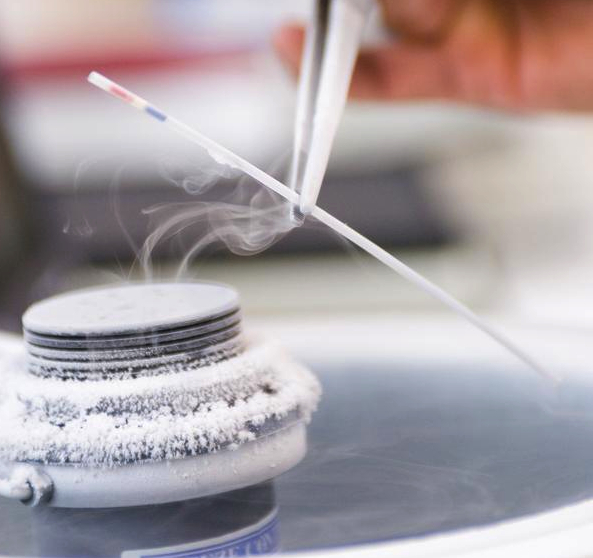Researchers are now intending to seek permission from the Human Fertilization and Embryology Authority (HFEA) to fertilize the eggs in order to test whether they are viable. Should such a study be successful, it would represent a breakthrough in fertility research and could open the door to greatly enhanced fertility for many women.
Tag: fertility clock
Infertility Terms You Should Know
If you are seeking fertility treatment, you will hear many new words you may not be familiar with. The following are infertility terms you may need to know to fully understand your treatment options:
Aneuploidy – An abnormal chromosome count. This is an indication of serious defects in a fertilized egg that usually lead to early miscarriage.
Artificial Insemination – Introduction of sperm into a female patient’s reproductive tract through means other than intercourse.
Basal Body Temperature – The low body temperature reached after a night of sleep before a person gets up and begins moving around. A slight increase in this temperature usually occurs upon ovulation.
Basal Body Temperature Charting – Recording each daily temperature, plotted onto a graph in order to ultimately recognize a pattern. Your body temperature can rise gradually, suddenly or in steps. These patterns can differ from cycle to cycle.
Clomiphene Citrate (Clomid) – Clomid is a drug that stimulates ovulation by increasing production of gonadotropins (pituitary gland hormones). This is a commonly prescribed medication for infertility that involves menstrual cycle irregularities.
Egg Donation – Young women who wish to assist an infertile couple in achieving a pregnancy may undergo a course of hormone injections to stimulate a large number of eggs to mature at once. These donated eggs are retrieved and may be used immediately or frozen.
Egg Retrieval – Eggs are removed from a patient’s ovaries for use in vitro fertilization. This outpatient procedure involves the use of a long needle inserted through the vaginal wall to suction the eggs from the ovaries.
Embryo – A fertilized egg is referred to as an embryo until about week 8 of gestational development. After this, the term fetus is used instead of embryo.
Embryo Biopsy – A diagnostic test used to identify chromosomal abnormalities. This procedure is done by removing a single cell from an embryo that is developing in an IVF dish. The biopsy does not interfere with normal development.
Embryo Cryopreservation – Freezing of fertilized eggs for future use. This step sometimes allows multiple IVF attempts to be carried out from a single follicle stimulation/egg retrieval cycle.
Embryo Transfer – Introducing embryos that have developed for several days in an IVF dish into a woman’s uterus. The embryos are transferred via a flexible tube inserted through the cervix.
Endometriosis – A painful medical condition that causes abnormal growth of endometrial tissue (the type of tissue that lines the uterus). Endometriosis can cause fallopian scarring and other issues that lead to infertility
Fibroid – A non-cancerous tumor that grows on the wall of the uterus. Fibroids can occasionally interfere with fertility.
FSH Injections (Gonadotropins) – Follicle Stimulating Hormones trigger the maturation of eggs in the ovaries and make them ready for retrieval. These hormones are injected just under the skin.
Gender Selection – Selection of the desired gender either through sperm sorting or the much more accurate method of inspecting a developing embryo prior to transfer into the uterus.
Hydrosalpinx – Blockage of the fallopian tube with a clear liquid that prevents the passage of an egg and results in infertility. This medical condition is typically caused by infection with an STD that damages the fallopian tube at the end nearest the ovary.
Intracytoplasmic Sperm Injection – Injection of a single sperm directly through the protective outer shell of an egg into the cytoplasm. The fertilized egg is kept in the IVF dish and observed to ensure fertilization and normal development before transfer.
Intrauterine Insemination – Sperm is collected from the male partner and processed to remove the semen components and concentrate the sperm. This sample is introduced into the female partner’s uterus. From there, the sperm travels to the fallopian tubes to fertilize an egg.
In-Vitro Fertilization – Sperm are introduced into an IVF dish that contains an egg so that fertilization occurs outside the patient’s body. The term In-Vitro Fertilization is often used to refer to the whole cycle of follicle stimulation, egg retrieval, fertilization, and transfer into the uterus.
MESA – Micro Epididymal Sperm Aspiration is a surgical procedure performed to retrieve sperm from the duct that stores sperm as it matures. It involves making a very small incision in the scrotum.
Oocyte Cryopreservation – Retrieval, freezing, and storage of a woman’s eggs for use in future fertility treatment.
Ovarian Reserve – The number of viable eggs a woman has remaining.
Ovulation – Release of a mature egg from the ovary into the fallopian tube where it can be fertilized. This normally happens once every 28 days about halfway through each menstrual cycle.
Ovulation Monitor – A device that measures hormones in the urine, sweat or other body fluids to determine when an egg is about to be released and can be used to pinpoint the best days for intercourse to achieve pregnancy.
Polyp – Excessive growth of endometrial tissue on stalks protruding from the lining of the uterus into the uterine cavity. These may cause miscarriage.
Pre-Implantation Genetic Diagnosis – Genetic screening of embryos for abnormal chromosome counts or mutations while they are developing in an IVF dish. PGD increases the success rate of IVF by detecting and screening out any embryos that cannot survive.
Semen Analysis – Evaluation of a semen sample to determine if the number, movement, and shape of a male partner’s sperm are normal.
TESE – Testicular Sperm Extraction is a surgical biopsy technique used to retrieve viable sperm from the testicles of men who cannot give a sperm sample by other methods.
Varicocele – A varicose vein occurring in the scrotum. When the valve in the vein fails, blood accumulates causing the vein to swell – potentially affecting fertility.
Vasectomy Reversal – Surgical reconnection of the vas deferens (ducts that carry sperm from the testicles to the point where the sperm is mixed with semen). This procedure may be used to restore normal fertility to a male partner.
Zygote Intrafallopian Transfer – Placement of a newly fertilized egg (zygote) directly into the fallopian tube. Returning the egg to its natural environment increases the chances of successful development and implantation.
From Infertility to Parenthood, Rolling With It
When my dear husband and I were undergoing infertility treatments I often daydreamed about a chubby cheeked, curly haired toddler, decked out in pastel Easter finery, frolicking in a lovely garden.
Egg Donations: A Honolulu Womans Story
I am not anonymous. I know who I am: I am my Caucasian mother’s stories of how much she has loved mothering; I am my Chinese father’s love for music and good deals; I am all the injury, heartbreak and observed suffering I’ve absorbed into my body, if not my genes, for the past 32 years. I am an egg donor, and my role in the lives of the couples I donate to ends the moment my last ova hits the aspirator.
Lose Your Keys? Blame Menopause
Women going through menopause, pay attention. That trouble staying focused and keeping track of things? It’s real.
Scientists to Apply for License to Fertilize Human Eggs Grown in Laboratory
Scottish scientists are set to revolutionise fertility treatment following the development of a new technique that could lead to a reversal of the menopause in older women.
Modern Medicine Fights the Biological Clock
Fertility treatments can increase the chances of getting pregnant, but there are risks involved for women racing the biological clock
About the Fertility Clock
The Fertility Clock was developed by Dr. John Jain and Brigitte Mueller as an educational element for the film “My Future Baby: Breakthroughs In Modern Fertility”.
The Fertility Clock provides a simple graphic that can be used to estimate the monthly chance of having a baby.
Age-related decline in natural fertility is due to both decreases in egg count and egg quality; egg quality refers to an egg’s ability to create a chromosomally normal embryo.
As seen in the Fertility Clock, monthly birth rates remain relatively stable through age 35 despite a 90% drop in overall egg counts. Thereafter, birth rates decline more rapidly probably as a result of waning egg quality.
The data used to create the Fertility Clock was taken from landmark works in the fields of Population Research and Developmental Biology.
Using data from historical populations (1) and the most comprehensive study of ovarian reserve to date (2), estimates for monthly birth rates and egg counts were plotted in an age-dependent manner, from birth to menopause.
The rates depicted on the Fertility Clock estimate the experience for most women. As with all biological systems exceptions do exist.
(1) Wallace WH, Kelsey TW. Human ovarian reserve from Conception to the Menopause. PLoS One. 2010 Jan 27;5(1):e8772.
(2) Bongaarts, J. and Potter, R.G. (1983). Fertility, Biology, and Behavior: An analysis of the proximate determinants. New York, NY: Academic Press, Inc.
What is Egg Freezing
What Is Egg Freezing?
Egg freezing is a breakthrough technology that allows women to freeze and store their eggs until a pregnancy is desired. At that time, the eggs are thawed, fertilized and transferred to the uterus as embryos.
Who May Benefit
Many women today are postponing childbearing because they are focused on a career, are returning to school, or because they simply haven’t met the right person. For these women, egg freezing is revolutionary, not just in its technology, but in the life choices it allows them to make.
Over 50,000 reproductive-aged women are diagnosed with cancer each year in the United States. Surgery, chemotherapy and radiation treatments typically lead to infertility by destroying the eggs. While options vary depending on age, type of cancer and cancer-treatment plan, egg freezing can provide these women the opportunity to preserve their fertility.
And finally, egg freezing can be useful for individuals with religious or moral objections to storing frozen embryos that remain following a routine IVF cycle.
How Egg Freezing Works
It takes approximately four to six weeks to complete the egg freezing cycle, which follows the same protocol as IVF. This includes birth control pills and self-administered hormone injections to stimulate the ovaries. Eggs are retrieved and are frozen immediately following retrieval. When embryo transfer is desired, the eggs are thawed, injected with a single sperm to achieve fertilization, and transferred to the uterus as embryos.
Storage
We recommend that at least ten eggs be stored for each pregnancy attempt. For women under thirty-eight years of age, we normally harvest ten to twenty eggs per cycle. Based on our success with embryo freezing, we believe that long-term storage of frozen eggs is possible.
Success Rates
Our most recent frozen egg pregnancy rates are among the highest in the country – approximately 50% with the vitrification method. This figure is well above the national average for frozen embryos. Furthermore, we anticipate continued success and improvement in these rates with our dedication to ongoing research in the field.
Safety
To date, approximately 1500 babies have been born worldwide from frozen eggs. Among these births, the rate of birth defects and chromosomal defects has been no higher than that which we see in the general population.
Cost
The cost of egg freezing is approximately $10,000 – $15,000 plus annual storage fees.
Genetic Markers May Help Predict Fertility Decline in Women
Researchers at the Stanford Institute for Stem Cell Biology and Regenerative Medicine have discovered genetic markers that may ultimately allow women to track and predict declining fertility.

